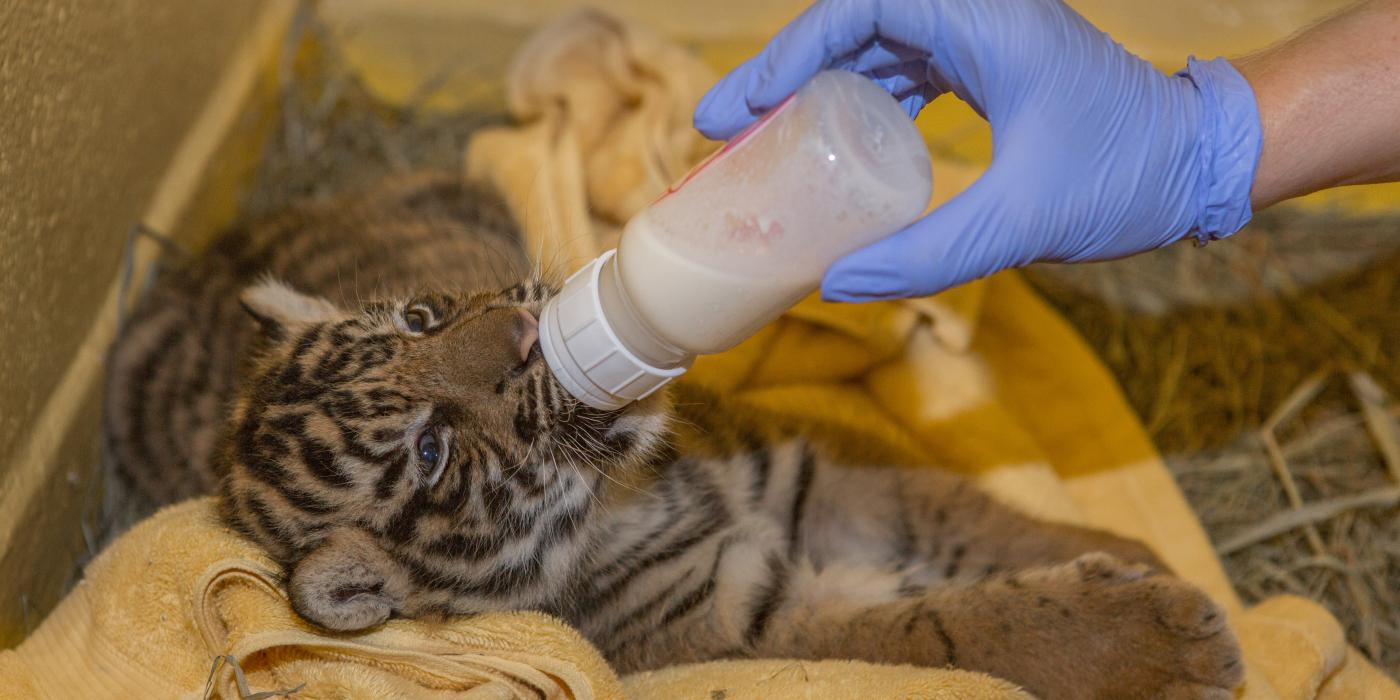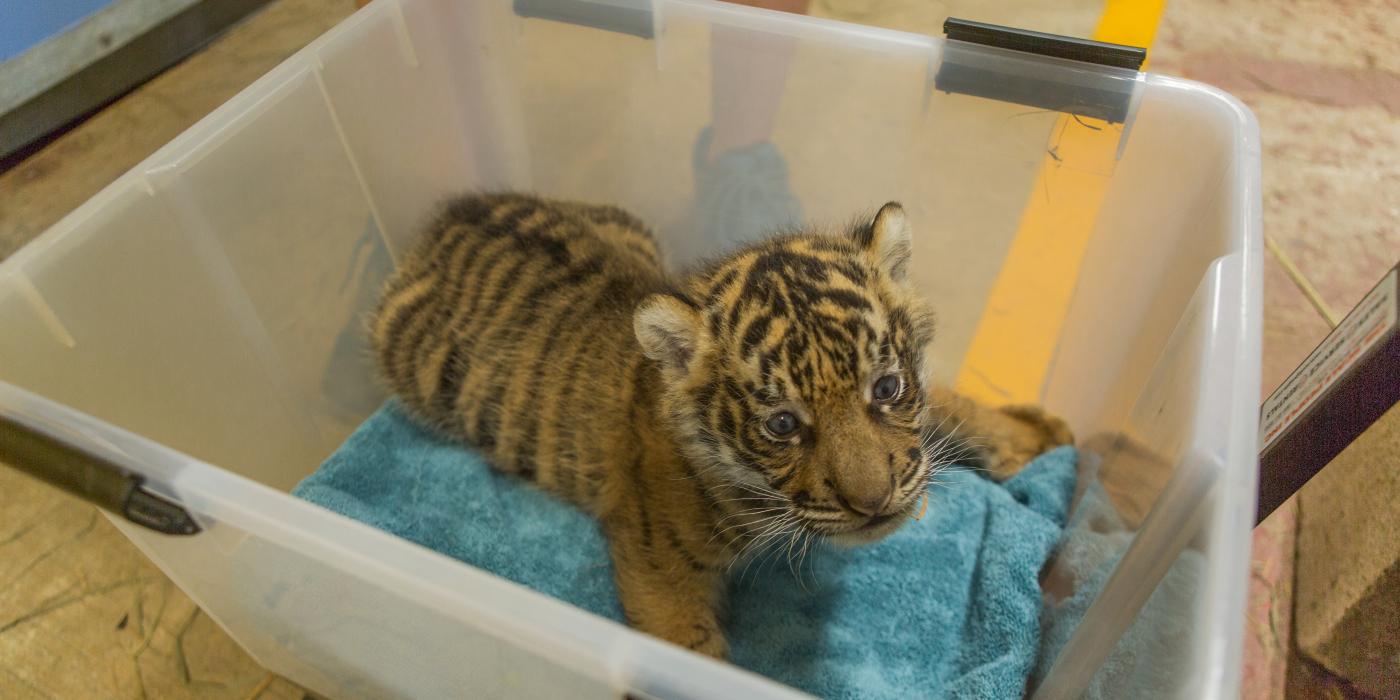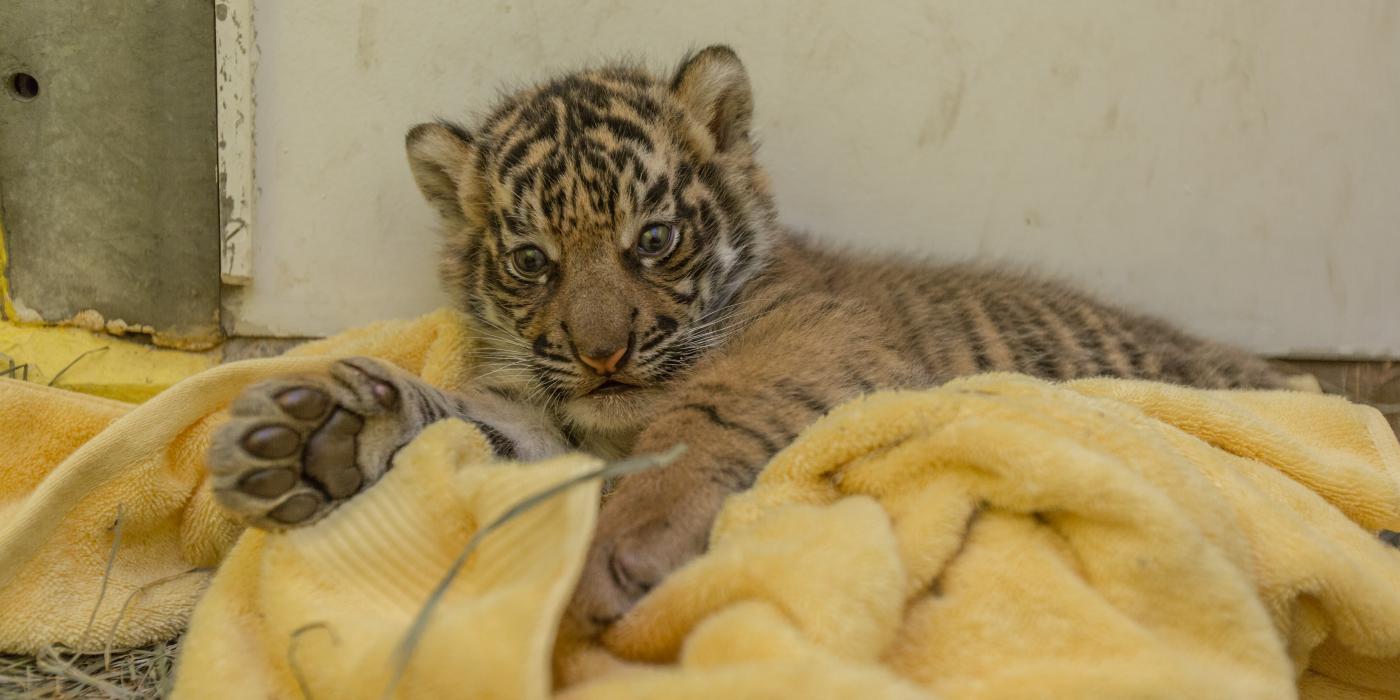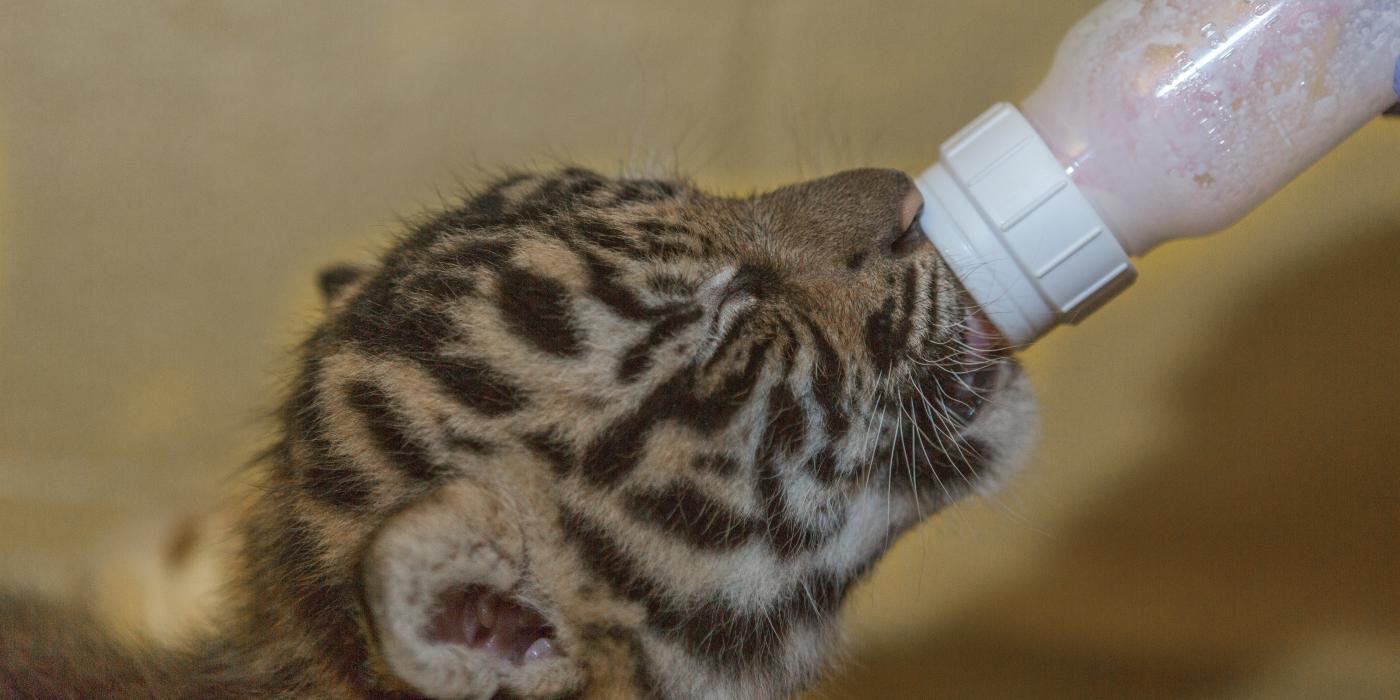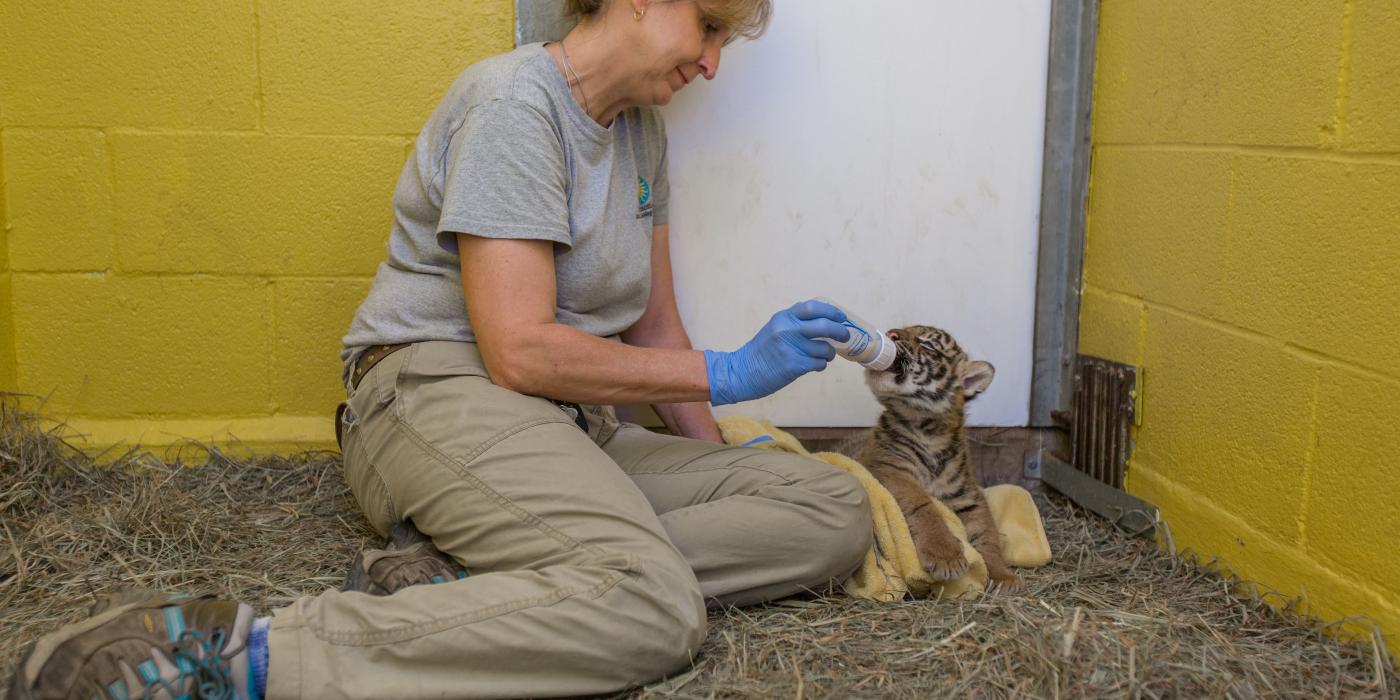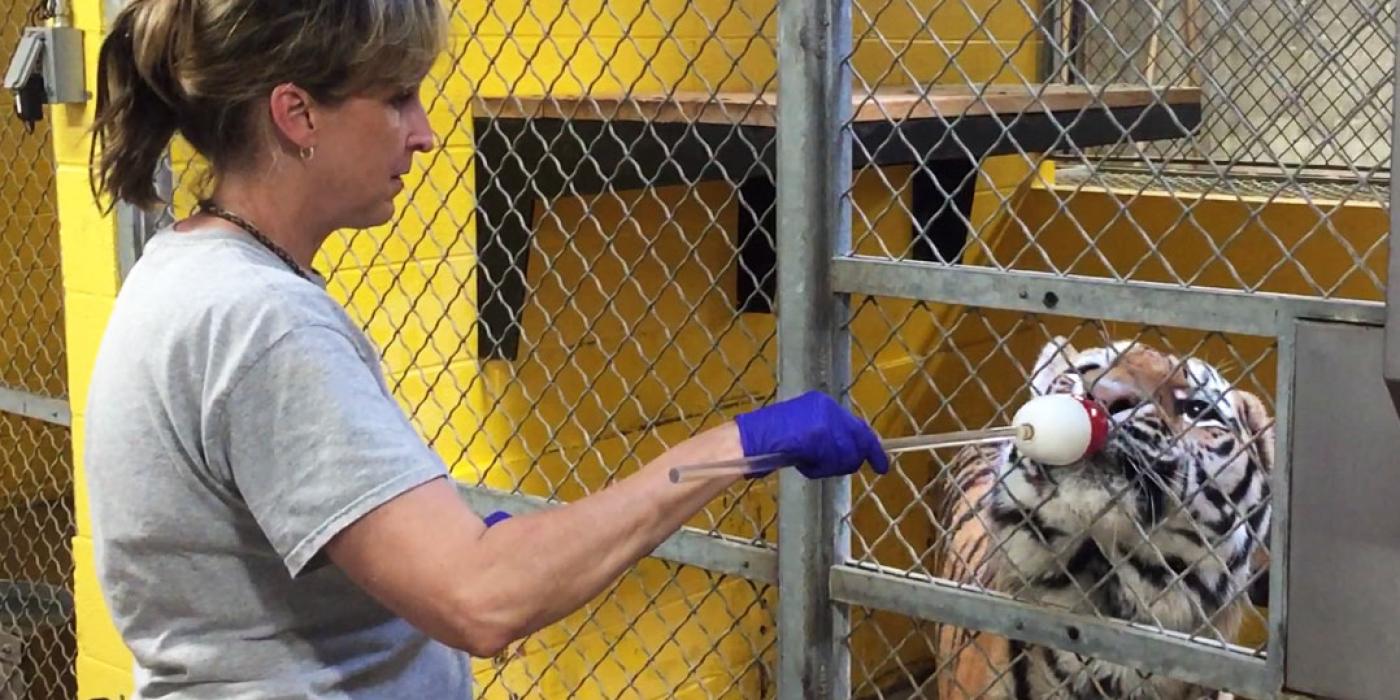Sumatran Tiger Cub Update: Supplemental Feeding
A baby’s arrival typically begets sleepless nights, round-the-clock bottle feedings and the proverbial village needed to successfully raise a helpless infant to independence. For Great Cats keepers at the Smithsonian’s National Zoo, who recently celebrated the birth of a Sumatran tiger cub July 11, those adages are all too familiar.
Animal care staff hope that any mammal born at the Zoo receives the care required from mom. Sometimes, however, that is not the case, and keepers must step in to assist. While the now 6-week-old male cub is still learning how to be a tiger from his 8-year-old mother Damai, the Great Cats team has been providing support through supplemental feeding since Aug. 2. When he was just 19 days old, keepers noticed that he was losing weight when he should have been steadily gaining. In addition, Damai displayed behaviors that concerned the keepers whenever the cub tried to nurse.
“Her behavior tipped us off that she was having either some pain or some difficulty nursing,” said Craig Saffoe, curator of Great Cats. “When he was positioned near her head or elsewhere in the enclosure, she would groom him and play as normal. But, as soon as he moved towards her belly, she would vocalize aggressively and push him away with her hind feet. This started out as intermittent behavior, but in the following days it became more frequent and more intense.”
The reason behind Damai’s odd behavior was not clear. Animal care staff debated the possibility that there could be something wrong with the cub that they could not detect, but Damai could; or that the problem may be with Damai. Perhaps she was experiencing pain due to mastitis; or, that she was having difficulty producing milk because only a single cub was demanding it; or, that she was in the midst of an estrus cycle—a somewhat odd occurrence for a nursing mother. Zoo veterinarians performed a hands-on exam of the cub and conducted a visual exam of Damai, but neither revealed an obvious medical cause for Damai’s behavior.
They began treating Damai for potential mastitis Aug. 1 with an anti-inflammatory and antibiotic to reduce her potential pain. The medications brought about positive results; Damai began nursing her cub again. But, several days after the anti-inflammatory treatment stopped, her aggression returned. Once again, she reacted poorly to the cub’s attempts to nurse and seemed to be in pain. To treat this, veterinarians prescribed another dose of anti-inflammatory medication. Unlike with the first dose, however, Damai’s aggression did not immediately subside.
From Aug. 1 through Aug. 8, Damai’s behavior became unpredictable—she would accept the cub’s attempts to nurse one hour, and reject them the next. Keepers kept a close watch on the pair’s interactions, and when Damai’s aggression toward the cub began to ramp up, they cued her to shift into an adjacent enclosure—a behavior that is part of the cats’ daily husbandry training routine. When she did so, they would lower the “howdy door” between Damai and her cub, such that they had visual access but were physically separated. When they observed Damai approach the door and make a friendly “chuff” vocalization, it was a signal that she was receptive to spending time with the cub. Her behavior suddenly changed Aug. 9; keepers observed her grooming, playing with and even allowing the cub to approach her belly.
“There is both an art and a science to animal husbandry,” Saffoe says. “The reason this cub is alive today is because our keepers are experts in knowing their animals’ behaviors, and because they kept meticulous records of the cub’s weight. Had the keepers not caught this weight loss early, the cub could have gone too long without getting sufficient food from mom. We had to take our cue from Damai’s behavior as to whether we kept them together or separated them. That level of intense care and observation meant that Damai’s transition back into her motherly instincts went very smoothly.”
To animal care staff, it was evident that whatever the underlying cause, Damai was either not producing enough milk or had stopped production altogether. Even when the cub would nurse for hours at a time, the scale would show that he gained little or no weight from that feeding. Keepers’ first priority became turning the cub’s weight loss into a steady gain. First, they had to acclimate the cub to drink from a bottle. While mom was outside, keepers would enter the den and offer him a small amount of formula. That way, by the time he needed to receive the bulk of his nutrition from supplemental feeding, eating from the bottle came second nature to him.
The Zoo houses the most extensive collection of exotic animal milks in the U.S.—more than 15,000 samples from more than 150 species. Physical samples are used to collect invaluable data as scientists continue to discover the secrets of lactation. Zoo nutritionists provided the keepers with the ingredients and recipe needed to sustain a growing cub: a combination of kitten and exotic animal milk replacers that were formulated to approximate the nutrient composition of tiger milk. Now that he is old enough to try solid foods, the formula is mixed with some turkey baby food.
Before the sun rises, keepers arrive at the Great Cats habitat. After a quick visual exam on Damai and her cub to ensure that no injuries, cuts or scrapes occurred overnight, they open the door that leads to the outdoor yard. Once she shifts outside, keepers place the cub on a scale to determine if he has lost, gained, or stayed the same weight compared to the previous morning. They relay his daily weight to Zoo nutritionists, who calculate the ideal amount to feed. For a nice, steady weight gain, keepers offer 15 percent of his body weight per day, divided over the day’s feeds.
Once keepers know the amount to feed, they combine all of the ingredients and sift them several times through a strainer. It takes about an hour to get all of the ingredients to a consistency where they can pass through the nipple. The first feeding occurs at 6 a.m., and the cub usually drinks his fill (about 50 to 75 percent of the bottle) in about a half hour. The keepers currently feed him 5 times a day; the last feeding occurs at midnight. The cub has also started eating small amounts of the ground beef-based feline diet that he will consume as an adult. As he grows, the amount of formula he receives and the number of bottle feeds per day will decrease as animal care staff increase the meat portion of his diet. Eventually, he will transition to eating an all meat diet.
“As the cub gets more mobile, sometimes he is more interested in playing than eating during feeding sessions,” says Dell Guglielmo, animal keeper. “He chews on the bottle, or gets distracted by some of his enrichment toys. As cute as that is, we know that it is our professional duty to get in the den, feed him, and leave quickly so that mom can take over. Luckily, she immediately cares for him once she comes back. That’s how it should be.”
“We are offering him this supplemental feeding because it’s clear, based on his weight, that this is his main—if not only—source of nutrition right now,” says Saffoe. “It is critical for us that we get him back with mom as quickly as possible so she can show him how to be a tiger. We don’t want to hand-raise him, because that has the potential to adversely affect his behavior when he is older and ready to breed. We want to have minimal impact on this cub so he can grow up to contribute to his species’ survival.”
According to Saffoe, the cub is in a healthy weight range. He weighs slightly less than Bandar, his 4-year-old half-brother, did at this age, but is on par with other male cubs that were born at the Zoo in years past. He is slightly above the average weight of all the Sumatran tigers his age according to historic information gathered from the Association of Zoos and Aquariums.
“We’ve seen remarkable physical changes in him,” said Guglielmo. “The more mobile he is, the more independent he becomes. Every day that we can keep Damai and her cub together is a victory. That’s one more day that he can socialize with mom and learn how to be a tiger.”
Although the cub will not make his public debut until later this fall, Zoo visitors can see Sparky and the cub’s half-sibling, 3-year-old male Bandar, at the Great Cats habitat. Friends of the National Zoo (FONZ) is celebrating his milestone birth with a special edition of the $65 Adopt a Tiger package, which will include both a mother and a cub plush.
Related Species:

